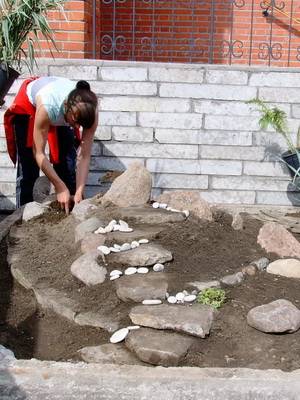Content
Building a rock garden with your own hands at your dacha is not as difficult as it might seem at first glance. Typically landscape designers deal with these issues, but having some skills, It’s quite possible to create a rock garden yourself.
How rockeries are used in landscape design, how to create your own rocky garden and what features of this composition should be taken into account first of all - all this is discussed in this article.
What is a rockery and what is it for?
Modern landscape designs are simply stunning with the variety of artificial structures, the abundance of strange plants and their combination. These include alpine slides, ponds, fountains, hedges and bizarre shapes. bushes. All this is designed to attract the attention of others, but The main purpose of landscape compositions is visual aesthetics. The garden should please the eye of the owner of the site and his guests at any time of the year.
Thus, rock gardens are usually decorated with cultures native to the mountain Alps. Whereas in rockeries you can use any plants that the owner likes best.
In essence, a rock garden is a rocky garden.The predominant part of the composition should be made of boulders, stones, and stone backfill. Plants in this case only serve as decor for an installation made of minerals; their role is to dilute the too dull stone landscape.
For this reason, lush shrubs, too bright flowers or dwarf trees are not used in rockeries. All this can be safely left to the rock gardens. For rockeries, saxifrage plants, climbing crops capable of entwining stones, and exotic compact bushes that delight with unusual greenery throughout the season are more suitable.
How to make a rock garden with your own hands
To create a rock garden at your dacha with your own hands, you need to analyze the entire process of building this composition step by step. Of course, it is much easier to turn to a qualified designer for help, but this pleasure costs a lot of money. In addition, many summer residents simply enjoy working with soil and plants, so creating a rock garden will give them considerable pleasure.
First of all, rockeries require site preparation. The first available plot in the garden will not be suitable for this composition. The placement of the rock garden should be thought through very carefully:
- It is not built in close proximity to the house. Firstly, the stone garden should be located against the backdrop of nature, and not a monumental building. And, secondly, rain and snow falling from the roof of a house can damage the structure, wash away the soil, contribute to the shrinkage of stones and the death of plants.
- You should also not place rockeries near large trees., against their background, small compositions risk getting lost. In addition, leaves from the trees will constantly cover the stone garden, which will require considerable effort to clean it.
- The best option is install a rock garden in a well-lit area, arranging the slopes of the structure so that most of it is on the shaded side. It is best if the long slope is oriented to the southwest or southeast.
- You should not refuse to build a stone garden on a small plot. Small, compact rockeries look no worse than spacious stone slopes. By selecting dwarf plant species for a miniature composition, you will be able to create a unique masterpiece.
- If the only place where you can install a rock garden is a corner near a fence or outbuilding, you can use a little trick. Namely - plant climbing plants near the wall of the building, choosing those varieties that have a decorative appearance throughout the year. Against the background of greenery, the rockery will look advantageous and natural.
Choosing stones for rock gardens
Rockeries are different, some use inconspicuous gray stones of approximately the same size, in others the designer plays on contrasts, combining calm background shades with bright inclusions of other rocks.
The choice of stones may depend entirely on the tastes and preferences of the garden owner.. According to the rules, rockeries are divided into three types:
- English garden. This composition involves the use of gray or beige stones with sharp edges, a sprinkle of decorative crushed stone and a simple geometric shape of the base. Here, most often, perennial coniferous crops are planted: shrubs or dwarf trees.Frequent “guests” of the English rock garden are cereals and bulbous crops. They are sometimes combined with saxifrage and climbing plants. The main rule of English rockery is durability. This design should please not only the current owners of the site, but also their descendants.
- European-style rockeryFirst of all, it should be comfortable. That is, require a minimum of time and money for maintenance and care. Stones in such compositions, most often they have a rounded shape - these are pebbles or forest boulders. It is allowed to install one or two large minerals with sharp edges, a combination of contrasting shades and different rocks. Among plants, Europeans use local crops that are accustomed to climatic conditions and soil composition, providing lush flowering and bright colors. Caring for such a rock garden is quite simple. If you choose the right plants, considering the time of their flowering, all that remains is to water the rockery on time.
- Japanese gardens impressive by the predominance of stones over plants. The entire design here is based on the layout and combination of stones. Very little attention is paid to greenery; flowers and herbs should not distract attention from the contemplation of the stone composition. Saxifragas, climbing herbs, and compact bushes are most suitable. A Japanese rock garden should evoke peace - this is its main purpose.
Guidelines for choosing stones come down to just a few simple recommendations:
- The stones should have an interesting shape - these could be porous stones, cobblestones with spectacular cracks, moss-covered boulders brought from the forest or black stones collected on the seashore.
- The color combination of the stones depends entirely on the wishes of the owner. For people with excellent aesthetic taste, it will not be a problem to effectively combine minerals of different shades into a single composition. For those who are afraid of mistakes, the best option would be to use stones of the same type and shade. In this case, you can “play” with the shape and size of the stones.
- Rockeries with one or two large central stones look best. The bulk of the minerals should be approximately the same size (about 35-40 cm in length or width).
- Any stones can be used for construction, the only requirement is that they must be strong to withstand moisture, sun and time.
- If very large stones are chosen for the rock garden, you will have to take care of special equipment with which they can be delivered to the dacha and installed in the designated place.
Assembling a rock garden
Step-by-step instructions for creating a rock garden with your own hands look like this:
- The location chosen for the structure must be cleared of weed and other garbage.
- Remove the top layer 10-15 cm deep from the soil. If the soil on the site is depleted, it is better to remove it and replace it with fertile soil or a purchased mixture. In this case, you will have to remove up to 40 cm of soil.
- The roots of weeds, bushes and trees are carefully removed from the soil.
- The area is covered with geotextile or polyethylene film. This will prevent the growth of weeds and the penetration of roots, which can move the stones and destroy the rockery.
- Due to the fact that the natural drainage of the soil is disrupted by the film, it is necessary to create an artificial drainage system. A layer of crushed stone, broken brick or slag is poured onto the bottom of the excavated hole. All this is sprinkled with coarse river sand.
- Now the soil is poured, the height of this layer depends entirely on the design of the rock garden and its design. After laying, the soil is compacted very carefully. Ideally, leave the rockery in this state until the next season (preferably for the winter), then the earth will settle naturally.
- Stones are installed according to the plan. Under the largest boulders it is necessary to add a cushion of crushed stone or even cement their base. This will protect against the inevitable subsidence of heavy stones.
- Add soil between the stones and compact it a little with your hands.
- Now you can plant the plants. They are selected in advance, and at the design stage, a location is determined for each of them. It is best to add fertilizer, soil or a growth accelerant to the hole for an individual flower - that is, to make the replanting as comfortable as possible for the flowers.
- The last step is to water the entire rock garden.
Tips and tricks
Every novice gardener may have a number of questions when building a rock garden; we will try to answer the most common of them:
- Step-by-step photos, video instructions and advice from “experienced” people will be of great help.
- It is not necessary to buy stones for your rock garden - they can be found “under your feet.” This will be especially easy for those who live near the sea or a fresh body of water; such stones are not afraid of moisture and have sufficient strength.
- There is no need to place the stones symmetrically - the rockery should look as natural as possible. It is best to start laying from the highest point of the structure, moving the stone relative to the center with each tier.
- A rock garden will look beautiful and well-groomed if the spaces between the stones and plants are filled with pebbles, decorative crushed stone or large sawdust. Among other things, this will prevent the growth of weeds.
- For the winter, it is better to cover rockeries with film or other material; this will protect both the plants and the structure itself from erosion and destruction.
- Plants chosen for decorating the composition should not exceed a height of more than 50 cm. Flowers on long stems and crops with minimal foliage do not look very nice here. Preference should be given to perennials that have a presentable appearance throughout the season.
Creating a rock garden with your own hands is not at all difficult; it does not require a lot of money and time. All the cottage owner needs is a clear plan, some stones and seedlings of his favorite flowers.

























